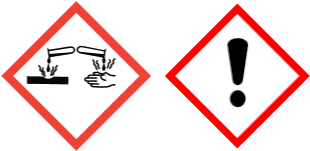1. Package information
25kg/plastic woven bags = 1000bags/20fcl = 25mts/20fcl
or as your requirements
*20fcl=20 feet container load
*mts=metric tons
2. Product Summary
Name: Oxalic Acid
Grade: Industrial Grade
Content: 99.6%
2.1 Identifiers
IUPAC Name
Oxalic Acid
Synonyms
Ethanedioic acid; Wood bleach; Crab acid
Molecular formula
C2H2O4
Molecular weight
90.034 g/mol
CAS No.
144-62-7
InChI
InChI=1S/C6H6O6/c3-1(4)2(5)6/h(H,3,4)(H,5,6)
SMILES
OC(=O)C(=O)O
ChemSpider
946
ChEMBL
ChEMBL146755
ECHA InfoCard
100.005.123
EC Number
205-634-3
PubChem CID
971
UNII
9E7R5L6H31
UN Code
3261
HS Code
2917111000
2.2 Physical and chemical properties
Physical State
Solid
Appearance
White
Odor
Odorless
Odor Threshold
No information available
pH
Ca.1 at 100g/L at 20°C (68°F)
Melting Point/Range
189.5°C (373.1°F) – dec.
Boiling Point/Range
No information available
Flash Point
No information available
Evaporation Rate
No information available
Flammability (solid, gas)
Not applicable
Upper Flammability or explosive limits
Upper explosion limit: 19.9 % (V)
Lower Flammability or explosive limits
Lower explosion limit: 4 % (V)
Vapor Pressure
21.5 hPa at 50°C (122°F) < 0.01 hPa at 25°C (77°F)
Vapor Density
No information available
Relative Density
1.9 g/cm3 at 20 °C (68°F)
Solubility
Ca.108 g/L at 25°C (77°F)
Partition coefficient (n-octanol/water)
logPow: -1.7 at 23°C (73°F) – Bioaccumulation is not expected
Autoignition Temperature
No information available
Decomposition Temperature
No information available
Viscosity
No information available
2.3 Spectral information
No data available
2.4 Safety and hazards information
2.4.1 Classification of the substance or mixture
GHS Classification in accordance with 29 CFR 1910 (OSHA HCS)
Acute toxicity, Oral (Category 4), H302
Acute toxicity, Dermal (Category 4), H312
Serious eye damage (Category 1), H318
Short-term (acute) aquatic hazard (Category 3), H402
2.4.2 GHS Label elements, including precautionary statements
Pictogram


Signal word
Danger
Hazard statement(s)
H302+H312
Harmful if swallowed or in contact with skin.
H318
Causes serious eye damage.
H402
Harmful to aquatic life.
Precautionary statement(s)
P264
Wash skin thoroughly after handling.
P270
Do not eat, drink, or smoke when using this product.
P273
Avoid release to the environment.
P280
Wear protective gloves/ protective clothing/eye protection/ face protection.
P301+P312+P330
IF SWALLOWED: Call a POISON CENTER/doctor if you feel unwell. Rinse mouth.
P302+P352+P312
IF ON SKIN: Wash with plenty of water.
Call a POISON CENTER/doctor if you feel unwell.
P305+P351+P338+P310
IF IN EYES: Rinse cautiously with water for several minutes. Remove contact lenses, if present and easy to do. Continue rinsing. Immediately call a POISON CENTER/doctor.
P363
Wash contaminated clothing before reuse.
P501
Dispose of contents/ container to an approved waste disposal plant.
2.4.3 Hazards not otherwise classified (HNOC) or not covered by GHS - none
2.5 Stability and reactivity
Reactivity
No data available
Chemical stability
Stable under recommended storage conditions.
Possibility of hazardous reactions
No data available
Conditions to avoid
Avoid moisture.
Incompatible materials
No data available
Hazardous decomposition products
Hazardous decomposition products formed under fire conditions. - Carbon oxides
Other decomposition products - No data available
2.6 Toxicological information
2.6.1 Information on toxicological effects
Acute toxicity
LD50 Oral - Rat - female - 375 mg/kg
Remarks: (ECHA)
Inhalation: No data available
LD50 Dermal - Rabbit - 20,000 mg/kg
Remarks: (Regulation (EC) No 1272/2008, Annex VI) (ECHA)
No data available
Skin corrosion/irritation
Skin - Rabbit
Result: No skin irritation
(OECD Test Guideline 404)
Serious eye damage/eye irritation
Eyes - Rabbit
Result: Risk of serious damage to eyes. - 24 h
(OECD Test Guideline 405)
Respiratory or skin sensitization
Local lymph node assay (LLNA) - Mouse
Result: negative
(OECD Test Guideline 429)
Germ cell mutagenicity
Mutagenicity (mammal cell test): chromosome aberration.
Chinese hamster lung cells
Result: negative
Ames test
S. typhimurium
Result: negative
In vitro mammalian cell gene mutation test
Chinese hamster lung cells
Result: negative
Carcinogenicity
IARC: No component of this product present at levels greater than or equal to 0.1% is identified as probable, possible or confirmed human carcinogen by IARC.
NTP: No component of this product present at levels greater than or equal to 0.1% is identified as a known or anticipated carcinogen by NTP.
OSHA: No component of this product present at levels greater than or equal to 0.1% is on OSHA's list of regulated carcinogens.
Reproductive toxicity
No data available
Specific target organ toxicity - single exposure
No data available
Specific target organ toxicity - repeated exposure
No data available
Aspiration hazard
No data available
Additional Information
Repeated dose toxicity - Rat - male and female - Oral - 90 Days - No observed adverse effect level - 63 mg/kg RTECS: RO2450000
Kidney injury may occur., Contact with eyes can cause: Damage to the eyes. To the best of our knowledge, the chemical, physical, and toxicological properties have not been thoroughly investigated.
Stomach - Irregularities - Based on Human Evidence
Stomach - Irregularities - Based on Human Evidence
2.7 Ecological information
2.7.1 Toxicity
Toxicity to fish
Static test LC50 - Leuciscus idus melanotus - 160mg/l - 48h Remarks: (ECHA)
Toxicity to daphnia and another aquatic invertebrate
EC50 - Daphnia magna (Water flea) - 162.2 mg/l - 48 h (OECD Test Guideline 202)
Toxicity to algae
Static test EC50 - Pseudokirchneriella subcapitata (green algae) - 19.83 - 21.35 mg/l - 72 h (OECD Test Guideline 201)
2.7.2 Persistence and degradability
Biodegradability
aerobic - Exposure time 20 d
Result: 89 % - Readily biodegradable.
Remarks: (ECHA)
2.7.3 Bioaccumulative potential
No data available
2.7.4 Mobility in soil
No data available
2.7.5 Results of PBT and vPvB assessment
PBT/vPvB assessment not available as chemical safety assessment not required/not conducted
2.7.6 Other adverse effects
An environmental hazard cannot be excluded in the event of unprofessional handling or disposal.
Harmful to aquatic life - No data available